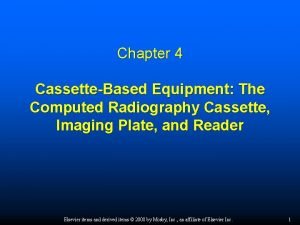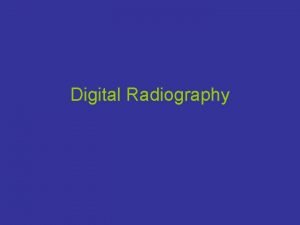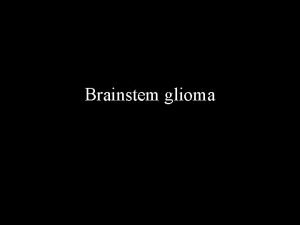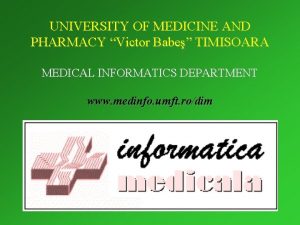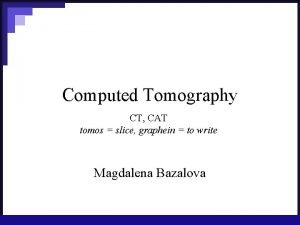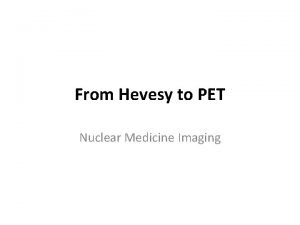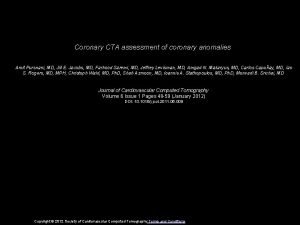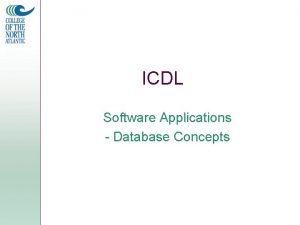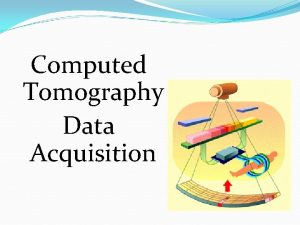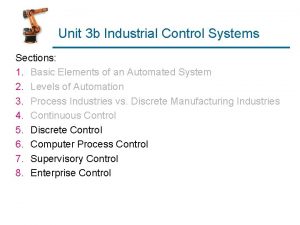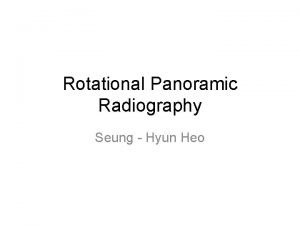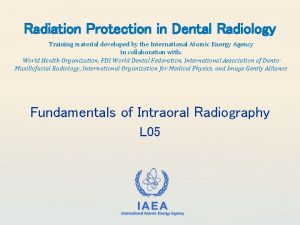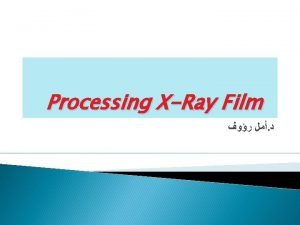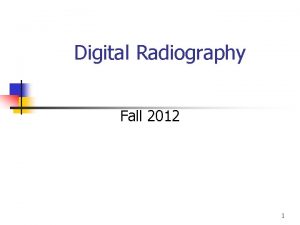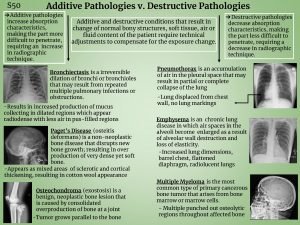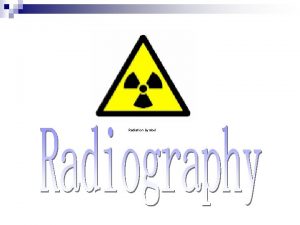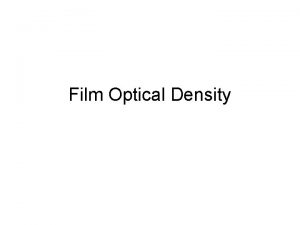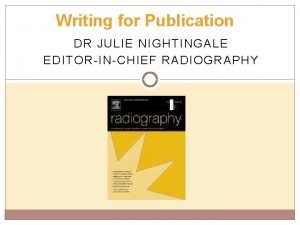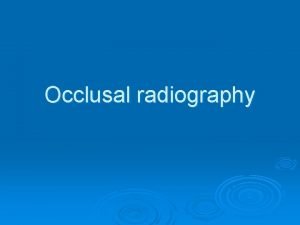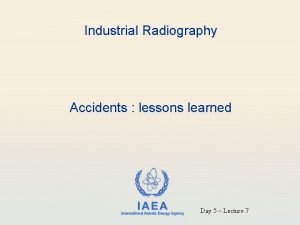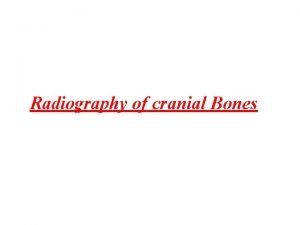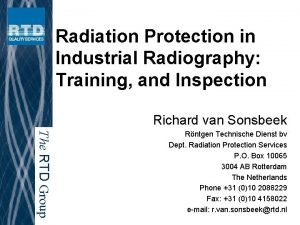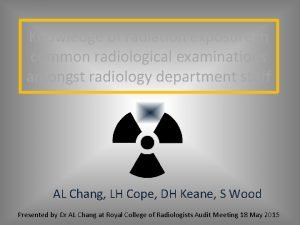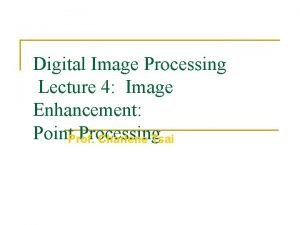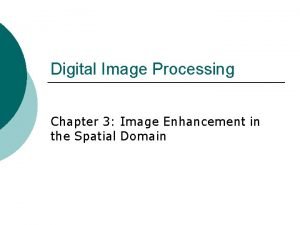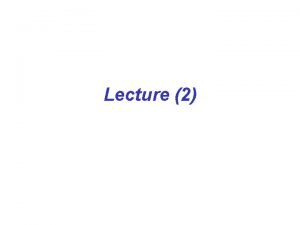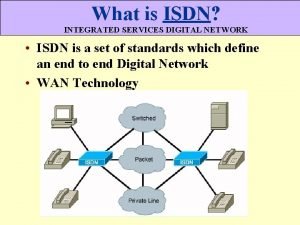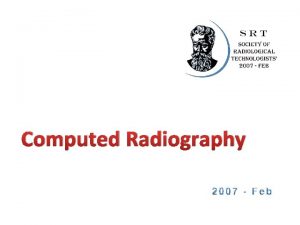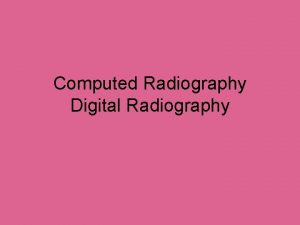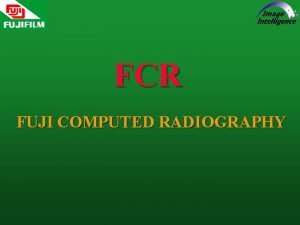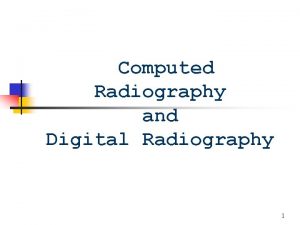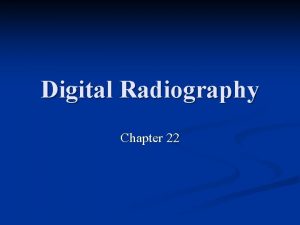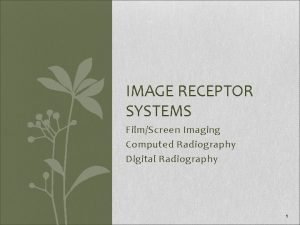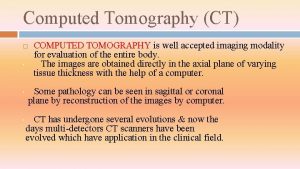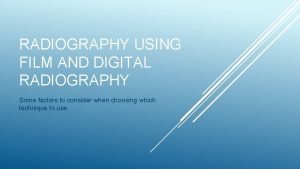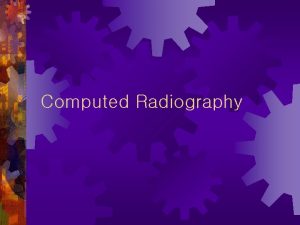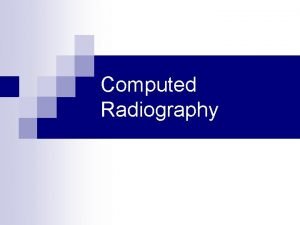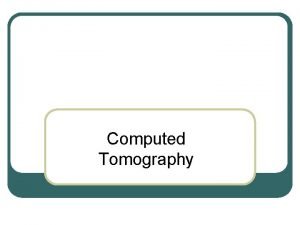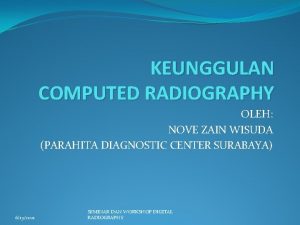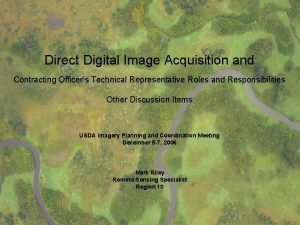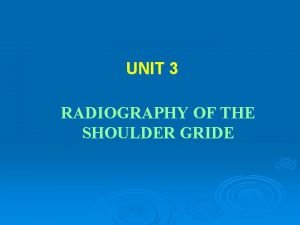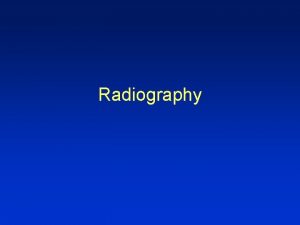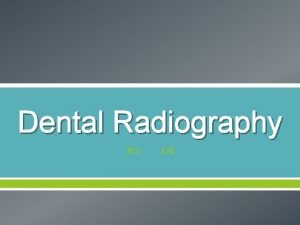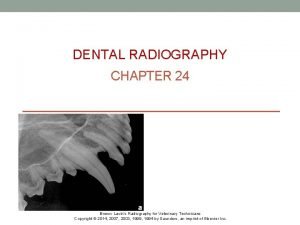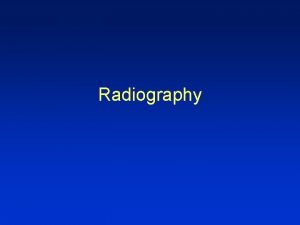Digital Radiography Computed radiography CR Direct radiography or





























































- Slides: 61

Digital Radiography

• Computed radiography, CR • Direct radiography or direct digital radiography, DR • Digital subtraction angiography, DSA

Computed Radiography (CR) is the generic term applied to an imaging system comprised of: ★Photostimulable Storage Phosphor to acquire the x-ray projection image ★ CR Reader to extract the electronic latent image ★ Digital electronics to convert the signals to digital form

• Computed Radiography (CR) uses very similar equipment to conventional radiography except that in place of a film to create the image, an imaging plate (IP) is used. The imaging plate is placed under the object to be examined and the x-ray exposure is made.

X-rays Cassette Conventional radiography Screen-film combination IP only

CR Detector • Photostimulable Storage Phosphor (PSP) • Ba. FBr compound, Eu activated Phosphor Plate Or imaging plate”IP” Barium fluorin bromide Cassette Holder Eu: europium

• instead of taking an exposed film into a darkroom for developing in chemical tanks or an automatic film processor, the imaging plate is run through a special laser scanner to read and digitize the image.


Computed Radiography “reader” Information panel Plate stacker







• The CR imaging plate contains photostimulable storage phosphors, which store the radiation level received at each point in local electron energies. When the plate is put through the scanner, the scanning laser beam causes the electrons to relax to lower energy levels, emitting light that is detected by a photo-multiplier tube (PMT), which is then converted to an electronic signal.

photo-multiplier tube



• The electronic signal is then converted to discrete (digital) values and placed into the image processor pixel map. • Imaging plates can theoretically be reused thousands of times if they are handled carefully, although handling under industrial conditions may result in damage after a few hundred uses. An image can be erased by simply exposing the plate to a room-level fluorescent light.


POST-PROCESSING


• The digital image can then be viewed and enhanced using software that has functions very similar to other conventional digital image-processing software, such as contrast, brightness, filtration and zoom.







Change the contrast Curve 1 Curve 2




GA GT GC GS RN RT RE 影像A 1. 2 E 1. 6 -0. 14 4 R 0. 5 影像B 0. 9 A 1. 6 -0. 42 4 R 4. 0

GA GT GC GS RN RT RE 影像A 1. 2 D 0. 7 0. 0 3 Q 1. 0 影像B 1. 1 A 0. 8 -0. 01 3 Q 5. 0

GA GT GC GS RN RT RE 影像A 1. 0 F 0. 7 0. 38 4 R 0. 5 影像B 1. 0 A 0. 7 0. 10 4 R 5. 0

GA GT GC GS RN RT RE 影像A 1. 4 0 1. 6 0. 7 4 Q 1. 1 影像B 0. 9 A 0. 8 0. 0 4 Q 5. 0

GA GT GC GS RN RT RE 影像A 0. 63 5 T 0. 5 影像B 0. 9 A 0. 6 0. 20 5 T 5. 0

GA GT GC GS RN RT RE 影像A 0. 9 E 1. 6 -0. 16 4 R 0. 5 影像B 0. 7 A 1. 5 -0. 58 4 R 5. 0 影像C -1. 3 A 1. 5 0. 66 4 R 5. 0

Subtraction










CR Networking • DICOM – Digital Imaging Communications in Medicine – Provides open architecture solutions for modality interfaces, storage/retrieval, and print functions • Technologist QC Workstation • Modality Worklist Input • Processed image output

Medical applications

• Computed Radiography systems are the most common in medical applications because of their low cost. • CR IP's can be used in multiple X-ray sites and the IP's processes through a single reader (scanner), similar to a film processor.

• No silver based film or chemicals; instead a computer is used. • Exposure times are a fraction of typical film exposures, which reduces occupational exposure to radiographers in field applications and is more economical. • Image acquisition is much faster; commonly one minute instead of seven minutes, as with conventional radiography.

• By adjusting image brightness and/or contrast, a wide range of thicknesses may be examined in one exposure, unlike conventional film based radiography, which may require a different exposure or multiple film speeds in one exposure to cover wide thickness range in a component. Computed radiography often requires fewer reshots due to under- or over-exposure. • Images can be enhanced digitally to aid in interpretation.

• Images can be stored on disk or transmitted for off-site review.

Disadvantages • CR is still not an approved method for most higher quality radiological applications (aerospace), due to the possibility of digital manipulation to the captured image, the inherent geometric unsharpness and resultant lower spatial resolution as compared to film (radiographic) images, SNR (signal vs. noise) issues and sensitivity to scattered radiation

• Imaging plates (IP's) are quite expensive and can be easily damaged, if the system being used requires manual handling of the IP's. Theoretically, IP's may be reused thousands of times, but constant use will always result in damage to the IP and image artifacts.

CR Trends • Lower system costs • Smaller footprint • High throughput systems • Low throughput systems “Table-top” units • Integrated QC workstations for images • DICOM output


 Cr cassette construction
Cr cassette construction What is computed radiography
What is computed radiography The zj row in a simplex table for maximization represents
The zj row in a simplex table for maximization represents How to calculate break even point in dollars
How to calculate break even point in dollars Condition
Condition Computed tomography timisoara
Computed tomography timisoara Computed tomography artifacts
Computed tomography artifacts Tracking signal definition
Tracking signal definition Computed tomography artifacts
Computed tomography artifacts Computed tomography
Computed tomography Journal of cardiovascular computed tomography
Journal of cardiovascular computed tomography A computed is a calculation that a dbms performs
A computed is a calculation that a dbms performs Data acquisition in ct
Data acquisition in ct Warga digital adalah...
Warga digital adalah... E-commerce digital markets digital goods
E-commerce digital markets digital goods Digital data digital signals
Digital data digital signals Digital data transmission
Digital data transmission E-commerce: digital markets, digital goods
E-commerce: digital markets, digital goods Digital encoding schemes
Digital encoding schemes Healthtech ecosystem
Healthtech ecosystem E-commerce digital markets digital goods
E-commerce digital markets digital goods Direct digital controls
Direct digital controls Define direct and digital marketing
Define direct and digital marketing Focal trough in panoramic radiography
Focal trough in panoramic radiography Air gap technique
Air gap technique Emulsion peel in radiography
Emulsion peel in radiography Latent image formation in radiography
Latent image formation in radiography Dental radiography ppt
Dental radiography ppt Filmless radiography
Filmless radiography What is recorded detail in radiography
What is recorded detail in radiography Pneumothorax additive or destructive
Pneumothorax additive or destructive Radiography safety precautions
Radiography safety precautions Darkroom entrance
Darkroom entrance Radiography barricade distance
Radiography barricade distance Optical density in radiography
Optical density in radiography Parallel grid cut off
Parallel grid cut off Gurney mott theory of latent image formation
Gurney mott theory of latent image formation Soot and whitewash radiography
Soot and whitewash radiography Industrial radiography accidents
Industrial radiography accidents Radiography
Radiography Lower standard occlusal radiograph
Lower standard occlusal radiograph Industrial radiography accidents
Industrial radiography accidents Rni radiography
Rni radiography Occipito-frontal
Occipito-frontal Industrial radiography training
Industrial radiography training Limitations of radiography
Limitations of radiography Buccal object rule dental radiography
Buccal object rule dental radiography Chapter 42 extraoral imaging
Chapter 42 extraoral imaging Mask mode radiography
Mask mode radiography Combining spatial enhancement methods
Combining spatial enhancement methods Histogram equalization
Histogram equalization Nephrosonography medical term
Nephrosonography medical term Msp meaning in radiography
Msp meaning in radiography Direct material + direct labour
Direct material + direct labour Write the time in digital form
Write the time in digital form Wisconcin digital archives
Wisconcin digital archives Digital footprint template
Digital footprint template Clock with missing numbers
Clock with missing numbers Define isdn
Define isdn Zooming and shrinking of digital images
Zooming and shrinking of digital images Digital footprint outline
Digital footprint outline Digital footprint calculator
Digital footprint calculator
